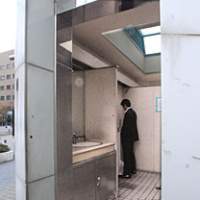Dear Alice,
Perhaps you have not paid much attention to men's restrooms in Japan, but in the vast majority of public toilets the urinals and the men using them are completely visible to anyone passing by. Do you think this is done on purpose? Or is it just the result of bad design? Japanese are generally very discreet, so it's hard to understand why the heck they are so public about this one thing.
Mauricio M., Tokyo
Dear Mauricio, Believe me, this is something that's hard not to notice. I too have wondered about the open nature of answering the call of nature, so I was more than happy to take your question over to the Japan Toilet Association. Chairman Koo Ue gave me a gracious reception but confessed he couldn't quite understand why we were asking.
"Is this so surprising for foreigners?" he queried. "Can't you see into men's restrooms in other countries?"
I explained that where I come from urination is a private affair, and many men would hesitate to use a urinal if they knew people could see. Ah, but in Japan, feeling safe is more important than privacy, Ue countered.
"Public toilets have an open design because Japanese want to be able to see inside before entering," he explained, to make sure no one's lurking in the loo. And simple designs, without privacy walls, take up less space and are cheaper to construct. "I don't think it's a big deal for Japanese to be seen, as long as it's from behind and our faces aren't visible."
Obviously, we are talking about Japanese men here, and the fact is that in Japan almost all users of public toilets are male. In one recent survey, Tokyo's Minato Ward found that 95.8 percent of those using its public restrooms were male, more than half of whom were taxi drivers. Surveys in other urban areas have yielded similar results. This begs the question: Where are all the women going when they have to go?
"Most Japanese women won't use a koshu toire (public restroom) unless they absolutely have to," said Katsumi Harada, one of Ue's female colleagues at the toilet association. "Although public toilets have improved, they are still thought of as gokei."
That last word, which is often written 5K, is one of those terms, much loved by the Japanese media, that describes something negative by listing all applicable adjectives that start with the "k" sound. The 5K of public toilets are kitanai (dirty), kusai (stinky), kurai (dark), kowai (scary) and kowareteiru (broken).
To avoid the 5K, many Japanese women go out of their way to find a bathroom at a hotel or department store. Or they stop in a coffee shop. In response, many local governments are now trying to make their public johns more welcoming to women. The Tokyo Metropolitan Government, for example, has announced a goal to have one daredemo ("anyone can use") toilet every 500 meters within the city boundaries. These are enclosed restrooms that are accessible to people with disabilities and suitable for use by either sex, including parents accompanying small children. Some municipalities are experimenting with pay toilets that offer relatively luxurious facilities.
The challenge when planning new public restrooms in Japan is finding the space. Land is expensive and residents often object to having a public toilet nearby. One trend, pioneered by the City of Kobe, is partnering with the private sector to open existing facilities to the general public, in exchange for an annual subsidy.
Japan has a long history of privies in public places, according to Eiki Morita, a high school teacher in Chiba Prefecture who has written several books on toilets in Japan, including one that catalogs 1,114 different ways to say "toilet" in Japanese. Morita told me it was common practice in the Edo Period (1603-1867), and probably much earlier, for farmers to put out shallow wooden tubs to collect waste from passersby, which they then used as fertilizer. Later, the government took over; the first privies paid for with public funds were built in Yokohama in 1872, largely as a public-health measure in response to new information from the West about waste-borne diseases.
It's not often I get to chat with an expert in toilet terminology, so I asked Morita to teach me some of the other ways of saying "toilet," something more interesting than toire, otearai and benjo. How about kawaya, Morita offered, a very old word for "privy" that appears in the "Kojiki" (a seventh-century text) and has been used right up until modern times, so most Japanese know it. More obscure is koyasan, a reference to Mount Koya in Wakayama Prefecture. The toilets at the temples there used running water, an innovation that was so advanced for the times that during the Edo Period the name of the mountain became a synonym for toilet.
Morita also had some interesting additional insight on your question.
"There is a lot of 'implied privacy' in Japan," he noted. "In traditional architecture, doors were paper thin, and of course you could hear right through them. So closing them was little more than a signal to others that they should pretend not to hear." It's the same with public toilets, he said. "Because passersby extend privacy by not looking, we feel less need for physical walls."



















With your current subscription plan you can comment on stories. However, before writing your first comment, please create a display name in the Profile section of your subscriber account page.